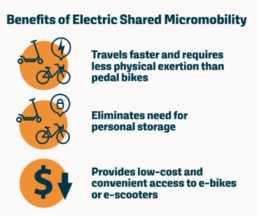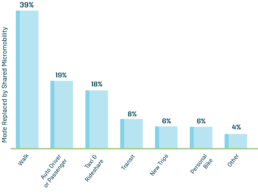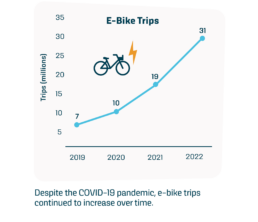A Look at the Benefits and Developments of Electric Shared Micromobility


As electrification in transportation is implemented as a solution to mitigate the climate crisis and we recognize that equitable access to emission-free transportation is critical, shared micromobility offers a solution. As nations and communities seek to electrify transportation, shared micromobility is an important piece of the puzzle.
Shared micromobility reduces barriers and increases access to e-bikes and e-scooters by providing service at a significantly lower cost than personal ownership and fulfilling the maintenance, storage, and charging needs of the devices for users. People across North America rely on electric shared micromobility to connect them to transit, essential services, and destinations that would otherwise be too far or cumbersome for walking or classic pedal bikes. Electric shared micromobility provides a transportation solution that is not only efficient, but it’s fun!
Electrifying bikeshare fleets and launching e-scooter fleets is an emerging trend across North America. The 2022 NABSA Shared Micromobility State of the Industry Report found that about 65% of shared micromobility trips taken in 2022– 103 million of the 157 million trips– were made on e-bikes and e-scooters, accounting for well over half of the 289,000 total vehicles deployed across North America. The availability of shared e-bikes and e-scooters encourages mode shift, helping people replace short car trips with more sustainable options like biking, scooting, and transit.


The popularity of electric shared micromobility has grown significantly since it was introduced. NABSA found that 7 million trips were made on e-bikes in 2019, 10 million in 2020, 19 million in 2021, and nearly 31 million in 2022. In 2022, e-bikes were ridden approximately 56% more than pedal bikes in systems that had both. The first all electric bikeshare system, Zyp, launched in Birmingham, Alabama in 2015. In 2017, electric shared scooters began to be part of the transportation landscape, proving to be an effective and fun mode of transportation. In 2018, Madison BCycle became the first bikeshare system to convert its pedal fleet to a 100% e-bike fleet. As electrification trends continued, shared e-bikes began to be introduced into bikeshare systems, even before the popularity of personal e-bikes began to boom. The percentage of systems that had e-bikes increased from 28% in 2019 to 44% in 2020, 50% in 2021, and 55% in 2022. Likewise, the percentage of systems that had e-scooters increased from 52% in 2019 to 58% in 2020, 64% in 2021, and 66% in 2022 and year over year, e-scooters account for nearly half of all shared micromobility trips. As we gear up for the release of the 2023 Shared Micromobility State of the Industry Report, we look forward to seeing what trends continue and sharing new metrics around fleet charging and rebalancing.
How are shared micromobility devices charged?
A key component to electrifying shared micromobility is of course the need to charge devices. Current charging elements include shared micromobility charging stations, charging cabinets, swappable batteries, and warehouse charging. To help manage the operational cost and create more efficiency than taking a bike or scooter off the street to charge at an offsite location, we are seeing a general trend of either charging stations or swappable batteries and in some cases a combination of the two.
Shared micromobility charging stations need to be powered. The two power source options are power from the electrical grid and solar power. In 2020, BIXI in Montreal, Québec launched the first shared micromobility charging stations in North America. In the spring of 2022, Divvy, in Chicago, Illinois, debuted the first grid tied-shared micromobility charging stations in the US. Just last month, the New York Department of Transportation and Lyft unveiled two of the first Citi Bike charging stations in New York City. In Vancouver, British Columbia, Vancouver Bike Share, operator of Mobi by Rogers, estimates significant operational cost savings if just 20% of their top performing stations were electrified.
Last year, NABSA released a resource highlighting the need to incorporate electric shared micromobility in electric vehicle charging projects. The resource examines the ways that EV charging projects can be leveraged to support shared micromobility charging infrastructure development and how funding can be effectively utilized to create sustainable multimodal transportation networks. As communities develop charging networks for electric vehicles, this resource helps encourage partners and stakeholders at all levels to think across sectors and modes as we work toward transportation decarbonization.
In addition to grid-tied shared micromobility charging stations, solar-powered charging stations have been implemented by shared micromobility programs in the US within the past few years. Research published in 2020, explored using solar energy to charge e-bikes and highlights the need for increased power at busy stations. In 2021, WE-cycle partnered with Skyhook Solar to charge e-bikes through solar charging stations creating the first network of solar-powered charging stations.
Charging cabinets have been and can be implemented for bikes and scooters that have swappable batteries. Charging cabinets are containers that offer a battery charging and storage solution. These can be implemented and installed with other shared micromobility infrastructure and help to reduce the travel time and need to take batteries back to a facility. In the summer of 2022, Lime deployed new batteries with the goal to increase ride time for users and reduce operational costs associated with battery swaps. Improving batteries to increase efficiency benefits not only the rider by extending the availability of power for a ride, it also has the operational benefit of reducing the frequency of charging.
As electric shared micromobility continues to trend, there is a growing opportunity for research. In 2023, NABSA’s Research and Data Committee (R&D) reviewed and determined research needs in shared micromobility. The need to research the ‘Impact of Electrified Stations’ acknowledges the need for more research exploring shared micromobility charging solutions. The other topic, ‘Impact of User Pricing and Equity Implications in Shared Micromobility,’ would address the balance of affordability and equity. Electric shared micromobility systems have more expensive equipment and are more expensive to operate – which continues to make the case for public funding support.
As we look ahead, we are excited to see what the future holds for electric shared micromobility innovation and development. This is really just the beginning for how shared micromobility can continue to be woven into the transportation ecosystem. We look forward to continuing the conversation with the release of NABSA’s 2023 Shared Micromobility State of the Industry Report and at the 2024 NABSA Annual Conference in Philadelphia, Pennsylvania this October.
